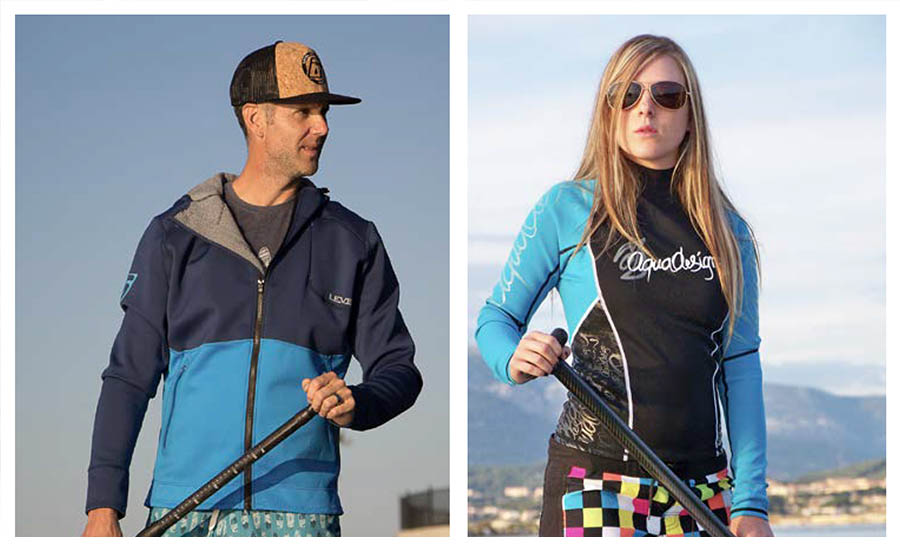“I think originally when people think neoprene they think smelly, hot, thick and bulky,” says Level Six Owner and founder Stig Larsson. It is a pre-conception that is quickly changing. “These are the traits that came with neoprene years ago”, clarifies Stig, “and while they still exist in cheap garments not made for performance, new technology has allowed neoprene to be extremely lightweight, stretchy, and now also breathable.”
WE see more and more outfitters showcasing new Neoprene fabrics and apparel, touting its versatility and appeal for watersports.
Level Six was an early proponent of the Neoprene revolution, manufacturing all their performance neoprene from a limestone-based neoprene rather than a petroleum-based one since 2014. This decision, combined with new lamination techniques and inner fabrics pioneered by the Level Six team allowed their brand to blend fashion and performance. “When consumers touch and feel our Sombrio and Jericho collections they can’t believe that these are constructed from neoprene. We make a hooded jacket out of this material that I’ve seen people wearing around town. It was a “must have” in Outside Magazines Gear Guide, and even made it into Chatelaine Magazine’s “must have” fashion section!” (Stig Larsson, Level Six)
NRS has also embraced the change, using Terraprene, a limestone based Neoprene. “Terraprene keeps you warmer thanks to thicker cell walls that reduce the compression of the material as you move, or sit. The thicker walls also help prevent loss of the inert nitrogen gas,” explains Marketing Director Mark Deming. For those unfamiliar with Neoprene, cells, or tiny bubbles, form in the material. It’s these cells, filled with inert nitrogen gas, that create neoprene’s insulating property. More cells equal more insulation, more warmth. Other Terraprene advantages? It is lighter, has more stretch and more buoyancy.
The trend reaches across the ocean, where companies like Palm Equipment Europe are revamping and expanding their Neo-flex range to include items such as bra tops and shorts that can be worn alone or under traditional dry gear. Palm’s Neoflex is made from super stretchy 0.5mm neoprene backed with a soft thermospan liner for a combination of warmth and stretch without the sweaty feel. Palm’s Marketing Manager Paul Robertson advocates for their Neoflex line. “Its only 0.5 mm thick and has four-way stretch, so its really, really flexible, especially when wet. This makes it pretty versatile in terms of how you can tailor it, allowing greater freedom of movement. Unless there is a lot of wind chill, its perfect for paddling, especially in warmer months. It will work OK under outerwear jackets, but its performance, like all neoprene, is best when wet.”
Companies like Vaikobi, Onda Wetsuits and Camaro are also embracing innovation opportunities with Neoprene technology, pairing Neoprene with Lycra to create warm yet breathable combinations, or lining Neoprene with Titanium® material to insulate by radiating body heat back to the wearer. Titanium® also has anti-bacterial properties which helps remove the “stinky” association.
“Neoprene has the ability to create a garment that is unrestricting, warm, and waterproof while being very durable,” clarifies Stig. “All of these factors make it a perfect fabric to use in our industry.” “Neoprene is kind of a staple in paddlesports,” agrees Peak UK’s Pete Astels.
But is it actually breathable?
Perhaps the word “breathable” is a bit of a misnomer. Neoprene is characterized as closed cell foam, making it waterproof, but also not breathable. However, with new technology “you can perforate the neoprene and then use lamination techniques to apply waterproof breathable membranes that maintain breathability and the warmth and waterproofness of traditional neoprene” (Stig Larsson, Level Six).
Slovenian based Sandiline is another company that has long explored breathable Neoprene techniques with their “flex airprene” material, made from perforated 1.5 mm Neoprene. Sandline uses “airprene” for liners in items such as their popular FP Double Shorts, and as a stand-alone layer in the AirVolution Shirt. Ventilated neoprene is at the core of Sandiline’s new Stand Out SUP apparel line with items ranging from bra tops to full-length pants. As more companies experiment with SUP apparel, performance neoprene will likely play a large role.
The possibility for innovation with Neoprene technologies is evident, and one that we will continue to see.
By: Anna Bruno, Kayak Session, Paddle World and Sup World Mag editor.


